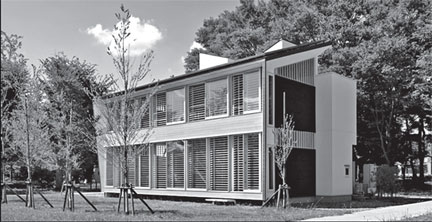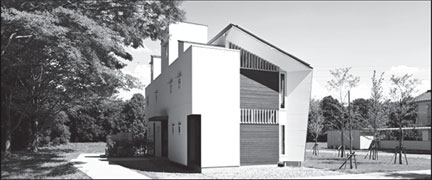Houses of the future
 What kind of house will you be living in 20 or 30 years’ time? The
truth is that today’s houses are not all that energy efficient. Even
with the available technology, one can live in a more sustainable way,
using energy resources wisely. Twenty or thirty years down the road,
technology will be sufficiently advanced to offer a totally sustainable
lifestyle centred on houses that are 100 per cent energy efficient. What kind of house will you be living in 20 or 30 years’ time? The
truth is that today’s houses are not all that energy efficient. Even
with the available technology, one can live in a more sustainable way,
using energy resources wisely. Twenty or thirty years down the road,
technology will be sufficiently advanced to offer a totally sustainable
lifestyle centred on houses that are 100 per cent energy efficient.
The recent electricity rate hike has opened the eyes of many to the
need for energy conservation.
We cannot afford to waste energy - the bill is just aspect of it -
but the overall picture is far more important. We have to move away from
depending too much on fossil fuels.
During my recent trip to Japan, I glimpsed two futuristic houses that
have envious ‘Green’ credentials. The first was in Tokyo itself, at the
Panasonic Centre. The second one was at the Building Research Institute
in Tsukuba (where many Sri Lankan scientists have studied). It is called
the LCCM (Life Cycle Carbon Minus) house.
These houses are part of the New Growth Strategy announced by the
Japanese government in 2010 that sets a long-term target of cutting
greenhouse gas emissions by 25 percent from 1990 levels by 2020. It was
prompted in part by the fact that emissions from residential sector in
Japan continued to rise in spite of the progress of heat insulation.
Construction
In such a background, the concept of an LCCM house was proposed as a
house which has a long service life, emits the least amount of CO2 while
constructing and using the house, creates recyclable energy by using
solar power generation and fuel cells. and results in a negative
life-cycle CO2 emission balance even with the CO2 emission during the
construction included.
 |
 |
|
Two houses in Japan |
CO2 emissions from LCCM houses decrease with the surplus energy for
operation and fall below zero after a period of years.
But it would be meaningless if all creature comforts have to be
sacrificed to save energy. For example, most solar panel installations
will restrict the number of items you can use simultaneously. You may
not be able to use the iron and the rice cooker at the same time. But
that would affect your lifestyle and time management.
Indeed, a drastic reduction of energy consumption for operation could
degrade health, safety, comfort and convenience. The ideal ‘renewable
energy’ house should still retain these elements to the maximum degree.
This is a major challenge faced by so-called ‘smart house’ builders
everywhere.
The LCCM house, completed just a month before the tsunami hit Japan
in 2011, underscores the importance of these goals. I was taken on a
tour of the house by senior BRI officials, who explained the
significance of the technologies used throughout the house.
Starting with the obligatory solar panels for power generation and
heating water, the four-person house features a raft of features that we
will probably be able to see in future houses. Among the other features
are: reserve power fuel cells; commercially grown wood from sustainable
forests or plantations (already available on a large scale); ventilation
towers for producing air current (minimises the need for
air-conditioning, though the LCCM features a new type of air
conditioner); LED lights (now being adopted widely) and even parabolic
walls that aid air and light penetration. The house is managed by an
‘intelligent’ Home Energy Management System (HEMS).
The house can adapt to both summer and winter conditions with a few
changes. The LCMM is now equipped with separate measurement devices for
all operational parameters (electricity consumption, amount of light
falling on the house and into rooms, water consumption, emissions etc.)
but the HEMS will essentially integrate all these in the future.
Technologies
The smart house at the Panasonic Centre too features a host of
technologies that eventually pave the way for zero emissions. In
addition to some of the features found at the LCCM house, Panasonic has
incorporated many of its energy saving electric and electronic devices
into the house, including a bathroom suite which is currently available
only in Japan and Taiwan. Renewable energies and recyclable materials
are at the heart of this house, copies of which are likely to be
commonplace in a couple of decades. Toyota too has built a similar smart
house, though I could not visit it. Such models houses have been built
in several other countries as well.
These houses are essentially long-term projects that will achieve
zero emission status in 20-30 years.
They have proved that it is possible to live a ‘green life’ even with
today’s technology, though there will be many more technological
advances during the next two or three decades in terms of renewable
energy, recycling, waste treatment, materials and household equipment.
The latest plug-in hybrid cars can already provide power to a house in a
two-way process.
High voltage Direct Current is making a comeback - it minimises
losses during transmission. New solar and wind power technologies are
taking shape. Most household appliances now feature energy saving
inverters. LED and CCFL bulbs are getting more advanced and cheaper by
the day. Tomorrow’s OLED televisions will consume even less power.
Authorities in Sri Lanka should follow these examples and encourage
local builders of houses, hotels and office buildings to give prominence
to environmental sustainability. Some of the steps are so simple - such
as allowing more natural light to come in - that they would not cost any
additional money. Some, such as solar power, do require an additional
outlay, but they pay off in a number of years.
The basic idea is that one can contribute to a greener world without
necessarily putting up a whole model house like the LCCM. It also helps
cut down on utilities’ bills and by extension, fuel bills on power
generation. Projects such as the LCCM have given us points to ponder on
living in an environmentally friendly way - a mission we can embark on
right now, even if the results could take a few years to show up. |


